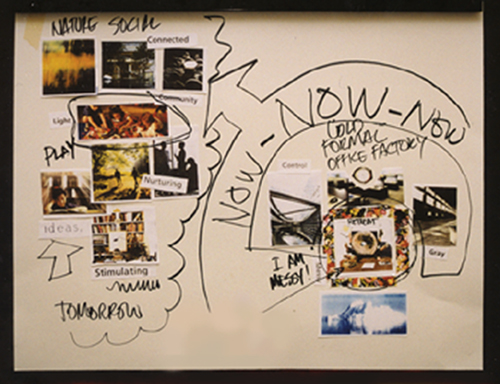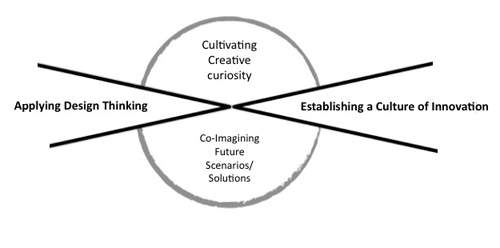By UditChaudhuri
Images: Courtesy Uday Dandavate
 |
| Three Types of Research |
CEOand co-founder of a global design research consulting practice SonicRim,based in the US, Uday Dandavate is focused on helping his clients cultivatecapacity for co-imagining the future and co-creating solutions that helpimprove the life of everyday people. He often pushes clients beyond theircomfort zone to identify unexplored opportunities to experience innovationthrough co-creation.
 |
| Uday Dandavate |
Avidworld-traveler, passionate champion of co-creation, political columnist, andrelentless design activist, Uday works with a wide range of people andorganizations at different levels. His curiosity for people, cultures andchange has drawn him to fields as diverse as anthropology, psychology,communication, sociology, marketing, politics and design. Seeking to rallypeople around macro issues, he often hits the road conducting workshops incolleges and companies, championing causes as diverse as ‘co-creation’, ‘MacroDesign’,and ‘sustainability’.
| Pattern Finding |
Udaycoined the term MacroDesign recognizing the need for designers to participatein the public policy domain. He is often invited to write for design andpolitical magazines, also to address corporate, not-for-profit and academicaudiences on change, innovation and co-creation.
| Co-Creation Workshop At JCI |
1 - Tellus about yourself and your work
I am a relentless explorer in search ofinsights, inspiration and ideas to make the world a better place. My valueswere shaped while growing up in a family committed to social justice andchange. My creative curiosity was shaped by education at the National Instituteof Design (NID). My systemic orientation to design research came from studyingtheories and methods from the fields of design, marketing, psychology,anthropology, and communication theory and politics during and after mygraduate education at Ohio. I gained a deep global perspective once I startedtraveling around the world as a design researcher and talked to thousands ofpeople about their lives and dreams.
I realize that designers can no longer beconfined to shaping the material world. With our abilities to solve problems,look beyond the obvious and fill the void with creative solutions, we need toparticipate in shaping public policy, public infrastructure and politicaldiscourse with design thinking.
 |
| Cognitive Maps |
2 - What prompted you to pursue a careerin design research?
The story of how I chose a career as a designresearcher is very interesting. As a practitioner of design in India during thefirst 13 years of my professional career, I was preoccupied conceptualizingproducts for functional, psychological, and business benefits. I realized thatmy innate craving to experiment with my work and affect change was notadequately matched by the expectations of my clients. I was feeling bored andstale and therefore decided to challenge my intellectual cravings at The OhioState University. That experience fuelled my curiosity and rekindled my spirit.
At NID,we were exposed to the ideas and creations of legendary designers and hadaccess to design publications from every nook and corner of the world. This exposure generated a craving in me tofollow the path of some celebrated designers, to produce designs that match theenchanting qualities of world-renowned designs. However, my path took me in anew direction.
I enrolled for a research-focused graduateprogram at The Ohio State University. Working with Prof. Reinhart Butter, Dr.Liz Sanders and Dr. Klaus Krippendorff (of Annenberg School of Communication),my curiosity shifted from designing products to understanding how peopleexperience design. I studied theoriesfrom fields of psychology, anthropology, marketing and communication. At thetime, Liz helped me get an internship at a global design firm, Fitch, whichlater turned into a full time job. Visiting people’s homes for research andunderstanding their lives and dreams brought me the joy of finding a connectionbetween design and life. In 1999, with three other partners from Fitch, I startedSonicRim, a design research consulting practice. Though two of the fourpartners are no more in the organization, Kevin and I continue to follow ourbliss through exciting projects that have global expanse. I am also fortunatethat many of our clients, who have an interest in India, encourage me to exploreopportunities that use their technologies to develop locally relevantsolutions.
| Immersive Displays of Insights |
3 - After 36 years in the field, what is that one thing you wish you could havelearnt as a student, which should have been part of your design schoolsyllabus?
I think the field of design and design educationare evolving through the 36 years I have spent in this field as a student ofdesign. I was fortunate enough to study in a school, where the focus was notmerely on ‘gaining knowledge’ and ‘acquiring skills’. Rather, we were told onthe first day at NID that the foremost thing to learn at NID was to unlearnwhat we had learned until then, and to open our minds to lifelong learning. Fromthat perspective, I would say there is nothing that I could have learned at thetime that I miss today, because mostly we were being trained to be lifelongobservers and learners.
Today, when I compete with some of the world’sbest firms in design research, what I learned at NID- sensitivity to theenvironment and openness of mind- is the core competency that helps medifferentiate my team and my company from any other design company in theworld. Our clients have repeatedly told us how much the openness, flexibility,and participatory nature of our thorough process at SonicRim has helped themcome back to us. In the words of one of our professors at NID, Prof. MohanBhandari - the core skill that we acquired at NID was to regain our ‘childlike freshness’in our view of life – a quality that comes in handy when I am confronted withsituations where pre-conceived notions get in the way of conceptualizingbreakthrough ideas.
 |
| Velcro Car- Inside |
4 - Two do’s that you couldshare with a student aspiring to pursue design research?
Conquer your ego. You can never change the worldor make an impact on others if your motivation for design is to serve your ego.On the other hand, if you gain the psychological capacity to keep your mindopen, ego in check, and seek empathy with people you design for, you willbecome a more successful designer and a change agent. Always remember that thereason you joined the design profession in the first place was to make theworld a better place.
Next, remember, a design is not just about form,function and aesthetic. It is important for a designer to know how one’s designwill fit people’s lives. Find ways to get into the heads of the people, whowill ultimately benefit from your design. Understand how they think, and figureout how or when your design will be a part of their life; then develop a designconcept that will blend well with their environment, their feelings and theirimagination.
| CDC workshop Bangkok |
5 - Two don’ts that you could sharewith a student aspiring to pursue design research?
Never fall in love with your idea; nor believethat there is one single solution to a problem. Life is made up of diversepeople with diverse perspectives. There can be many solutions that serve theproblem you are trying to solve. So be flexible, play and bring delight to thisworld through your ideas and creations.
Secondly, don’t ever evaluate your design basedon your criteria of good design. Test it with a group of people that representsthe profile of your target user or audience. I have often seen great insights fromresearch or design ideas that are best suited to target audience’s preferencesbeing killed by designers (or clients) just because those ideas did not matchtheir own tastes or preferences.
 |
| Remote Monitoring of Behaviors |
 |
| Designers' Role |
You can connect with Mr. Uday Dandavate by posting your comments below or via SonicRim
Thanks for such valueable comments for designers :)
ReplyDeleteThank you so much for sharing the thoughts... it is very motivating...
ReplyDeleteThis was a fascinating interview. I'd be interested to know whether India's new wave of design education institutions will be true to the original NID mission "to unlearn what we had learned until then, and to open our minds to lifelong learning..."
ReplyDelete